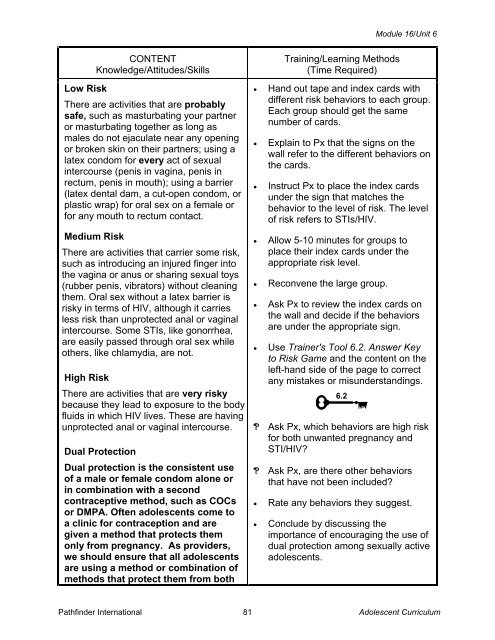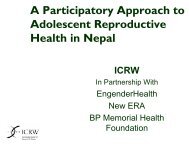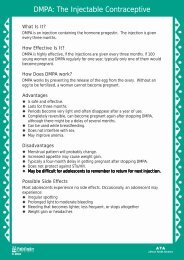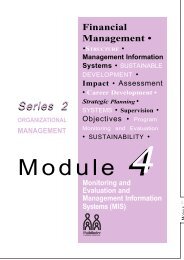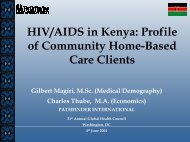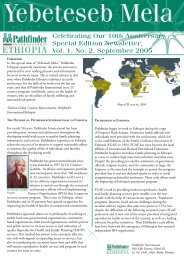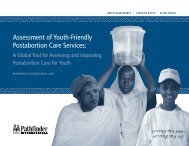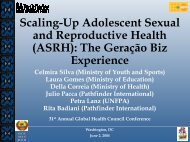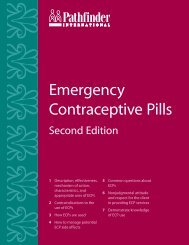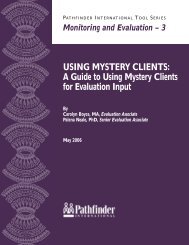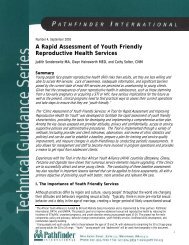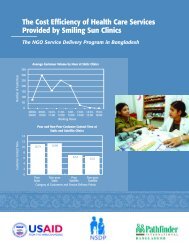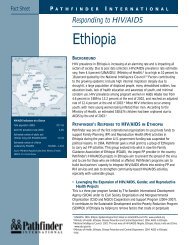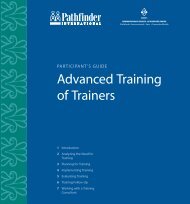reproductive health services for adolescents - Pathfinder International
reproductive health services for adolescents - Pathfinder International
reproductive health services for adolescents - Pathfinder International
Create successful ePaper yourself
Turn your PDF publications into a flip-book with our unique Google optimized e-Paper software.
Module 16/Unit 6<br />
CONTENT<br />
Knowledge/Attitudes/Skills<br />
Low Risk<br />
There are activities that are probably<br />
safe, such as masturbating your partner<br />
or masturbating together as long as<br />
males do not ejaculate near any opening<br />
or broken skin on their partners; using a<br />
latex condom <strong>for</strong> every act of sexual<br />
intercourse (penis in vagina, penis in<br />
rectum, penis in mouth); using a barrier<br />
(latex dental dam, a cut-open condom, or<br />
plastic wrap) <strong>for</strong> oral sex on a female or<br />
<strong>for</strong> any mouth to rectum contact.<br />
Medium Risk<br />
There are activities that carrier some risk,<br />
such as introducing an injured finger into<br />
the vagina or anus or sharing sexual toys<br />
(rubber penis, vibrators) without cleaning<br />
them. Oral sex without a latex barrier is<br />
risky in terms of HIV, although it carries<br />
less risk than unprotected anal or vaginal<br />
intercourse. Some STIs, like gonorrhea,<br />
are easily passed through oral sex while<br />
others, like chlamydia, are not.<br />
High Risk<br />
There are activities that are very risky<br />
because they lead to exposure to the body<br />
fluids in which HIV lives. These are having<br />
unprotected anal or vaginal intercourse.<br />
Dual Protection<br />
Dual protection is the consistent use<br />
of a male or female condom alone or<br />
in combination with a second<br />
contraceptive method, such as COCs<br />
or DMPA. Often <strong>adolescents</strong> come to<br />
a clinic <strong>for</strong> contraception and are<br />
given a method that protects them<br />
only from pregnancy. As providers,<br />
we should ensure that all <strong>adolescents</strong><br />
are using a method or combination of<br />
methods that protect them from both<br />
Training/Learning Methods<br />
(Time Required)<br />
• Hand out tape and index cards with<br />
different risk behaviors to each group.<br />
Each group should get the same<br />
number of cards.<br />
• Explain to Px that the signs on the<br />
wall refer to the different behaviors on<br />
the cards.<br />
• Instruct Px to place the index cards<br />
under the sign that matches the<br />
behavior to the level of risk. The level<br />
of risk refers to STIs/HIV.<br />
• Allow 5-10 minutes <strong>for</strong> groups to<br />
place their index cards under the<br />
appropriate risk level.<br />
• Reconvene the large group.<br />
• Ask Px to review the index cards on<br />
the wall and decide if the behaviors<br />
are under the appropriate sign.<br />
• Use Trainer's Tool 6.2. Answer Key<br />
to Risk Game and the content on the<br />
left-hand side of the page to correct<br />
any mistakes or misunderstandings.<br />
6.2<br />
Ask Px, which behaviors are high risk<br />
<strong>for</strong> both unwanted pregnancy and<br />
STI/HIV<br />
Ask Px, are there other behaviors<br />
that have not been included<br />
• Rate any behaviors they suggest.<br />
• Conclude by discussing the<br />
importance of encouraging the use of<br />
dual protection among sexually active<br />
<strong>adolescents</strong>.<br />
<strong>Pathfinder</strong> <strong>International</strong><br />
81<br />
Adolescent Curriculum


